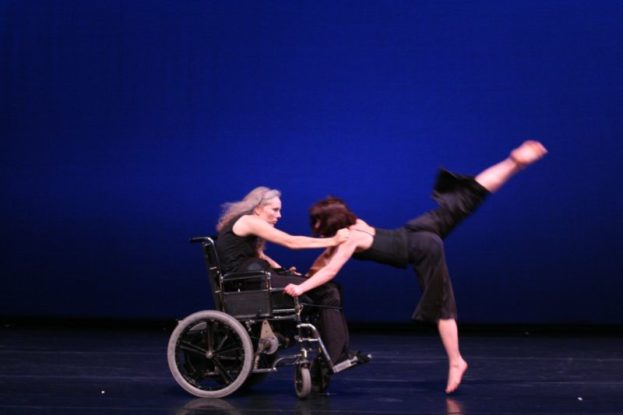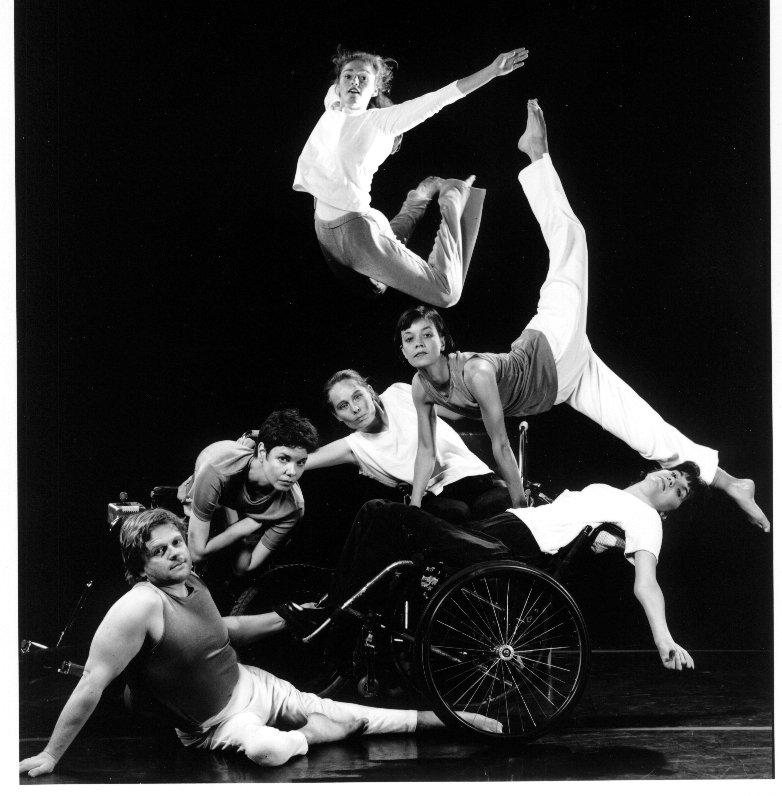
Judith Smith and Sonsheree Giles / photo by Trib LaPrad
“Just as ripples spread out when a single pebble is dropped into water, the actions of individuals can have far-reaching effects.” – Dalai Lama
True enough, but you also have to know that the farther out you throw the stone, the bigger its circular patterns will be. When in 1987 founding Artistic Director Thais Mazur of the Oakland-based AXIS Dance Company invited a group of disabled and able-bodied dancers to create a work, she probably didn’t think that this pebble would still make ripples 30 years later.
One of the women Mazur asked to participate was Judith Smith, who had to forgo a career as an equestrienne after a car accident left her in a wheelchair. The two had met at Hand to Hand Kajukenbo, a women’s martial arts/self defense program in Oakland, where Smith helped organize a class for disabled women. Smith remembers that having been introduced to improvising by a personal care giver, she had become passionate about studying contact improvisation and martial arts/self defense training. “I became so much stronger and more independent. It completely changed my attitude towards my body and my disability. Yet when Mazur asked her she had doubts because she had no dance training. “I started out with four left wheels,” she smiled. Previously unknown worlds opened as she went to every dance performance she could get to, ushering at places like Theater Artaud and Cal Performances.
From the beginning AXIS included dancers with and without disabilities; the disability movement was in its infancy but the eld of dance was changing by becoming less easily definable. AXIS quickly drew attention with its participation in the Dance Brigade’s 1988 “Furious Feet Festival for Social Change” and in 1989 for its role in the Revolutionary Nutcracker Sweetie. Terry Sendgraff offered them her studio for rehearsal and invited the company to set a piece for her Motivity presentations. “Both the disability community and the dance community became excited,” Smith says.

The works were collaboratively created and, remembers Smith, often dealt with disability. When he was still with the Walker Center in Minneapolis in the early nineties, John Killacky, now Executive Director of the Flynn Center for the Performing Arts in Burlington, Vermont invited AXIS to perform. “I was interested in what they were doing,” he said recently, “because while there was a burgeoning disability movement, there were not a lot of mixed abilities companies of quality out there. Most of them were built on a therapeutic model when people of various disabilities came together.”
In Minneapolis, in Killacky’s words, “[AXIS] received a terrible review from the local dance critic who talked about how he wanted this company to take itself more seriously in terms of choreography.” Killacky had long conversations with Smith who admitted that they sometimes got “sympathy” reviews (“look how special these people are”).
Smith knew choreographers she loved and admired like Joe Goode, Sonya Delwaide, Joanna Haigood and Bill T. Jones. She came to realize that AXIS needed to widen its reach. It needed to train disabled dancers and invite outside choreographers. This awareness brought about a painful in-house rupture. Nina Haft, who had joined AXIS in its second year and was a Teaching Associate at the time, also remembers underlying tensions because “we weren’t very experienced in talking about disability issues. Disability was right under the surface of everything that we did.” She thinks AXIS was lucky that Smith decided to stay on because “she was disabled but also a very gifted arts administrator.”
Haft learned basic choreographic skills from AXIS. “We would bring in clear questions and then investigate them on our own bodies. Cohesion came from people embracing and leveraging their own unique artistic abilities. This was not how I had been taught.” It is still the way Haft works today. “I wouldn’t be the choreographer I am without AXIS,” she acknowledged.
Since the dancers didn’t have access to training, they mainly worked with each other. When Smith took over in 1997 she decided that everyone in the company should learn to teach. It allowed the company to grow its outreach work. They also developed an education program in the schools for kids with a variety of challenges.
Two years after the breakup, in 2000 AXIS premiered Delwaide’s Chuchotements (Whisperings), Goode’s Jane Eyre, Haigood’s Descending Cord and Bill T. Jones’ Fantasy in C Major. These works got enviable local attention but Smith recalls “it was ‘Bill T. Jones’ Fantasy in C Major that put us on the map.” She is still amazed at her own naivete and recklessness about reaching so high. She also recalls that “Bill was incredibly patient with us because we were pretty green. We had three weeks instead of the more customary six weeks of rehearsal so we hired Sonya [Delwaide] as our rehearsal director. That piece kicked our butts.”
Nobody got paid for either rehearsals or performances, and everybody had outside jobs. “This company was built on sweat equity, and I am forever grateful to everyone,” Smith acknowledges. Today AXIS has a full-time staff of five and two part-time associates; the dancers receive a salary and health insurance. When Smith took over AXIS’ budget was $60,000; today it is $950,000.
Smith has commissioned over 40 pieces from inside the company, local choreographers but also national ones such as David Dorfman, Steven Petronio, Victoria Marks, Kate Weare, and Anne Carlson. To find the right match, Smith looks at a lot of work and tries to see something that might be responsive to the dancers. The relationships often start with workshops in which choreographer and dancers get to know each other—not in terms of the “equipment” used but in terms of the people involved.
Yet finding the right dancers is an ongoing challenge, and not only for dancers with disabilities. She wants everyone to be adventurous, curious, and brave. These days AXIS tours extensively which has helped to spread the word about integrated dance. Killacky thinks that AXIS is still the best in the country and soon will be considered just another modern dance company.
While Smith is gratified by the successes so far, she doesn’t think enough progress has been in terms of training dancers with disabilities and offering them performance opportunities. The quality she sees is not good enough, and even AXIS can get stronger.
The Australia-raised Marc Brew, AXIS Artistic Director since January, who was a dancer before becoming disabled, is an excellent choreographer, and an experienced director and teacher with an international career. According to Smith she found the right person to take AXIS to where it needs to go now. After another world premiere in London the other day, Brew who has worked with the company off and on since 2011, emailed some information on where he wants the company to go. All is based on AXIS’ three pillars of Artistry, Education, and Advocacy. Brew has already hired a full-time rehearsal director, increased the size of the company to six dancers plus an apprentice, and instigated regular company classes. He wants to enhance the artistic quality by bringing in first-rate artists and teachers and assembling a cohesive artistic team. Through participation in national and international festivals, he hopes AXIS will gain a more international profile even as it expands its local school programs and becomes more embedded in Oakland’s identity.
As for Smith, she will shift from Artistic Director to a more focused advocacy role. She will spend the majority of her energy on fundraising and raising the bar for integrated dance. Last year, she organized a national convening and six regional meetings: The Future Of Physically Integrated Dance in the USA which brought together over 300 dancers, administrators, educators, presenters and funders to exchange ideas, plan strategies and connect with each other. As Smith told In Dance last December: “After 30 years of trying to make a place in dance for AXIS and others like us. I feel it’s finally happening. . . I no longer have to convince the eld that this is important, vital and frankly the right thing to do. The momentum is palpable and the time is right.”
Take it for granted. In the next part of her career, Smith will not make ripples. She’ll create waves.


